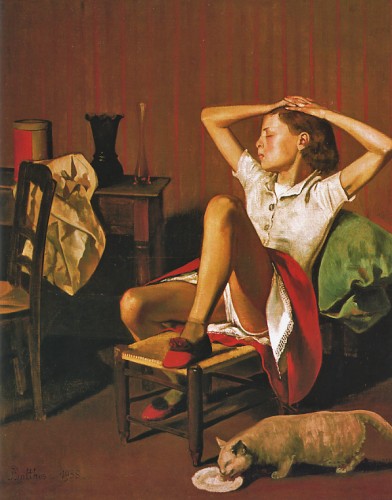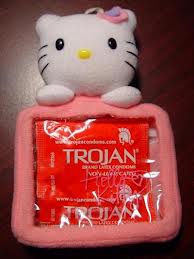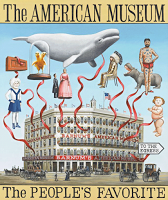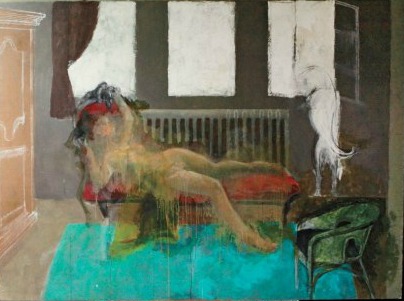Why Balthus at the Met? “Balthus: Cats and Girls — Paintings and Provocations” is on display at New York’s Metropolitan Museum through Jan. 12. Cats and Girls? Such a serious theme!
Barn cats are fine; they earn their keep. But house cats are useless. Unlike doggies, they do not offer unconditional love. You can’t teach cats to fetch, sit up and beg or shake hands. This, I am afraid, is why many people love them. They are relatively independent. They do not dream of greeting their masters or mistresses, but of killing small animals by chewing off their heads, toying for as long as possible with the quivering little bodies. On the other hand, there is no such thing as a watch cat.
One of my favorite Facebook sites is Hello Kitty Hell. The Hello Kitty image takes felinephilia to an extreme of cuteness that, I am told, even Japanese schoolgirls are beginning to abhor. Visit this site at your own risk.
A while ago, my Facebook profile picture was that of a cat with a cancel sign, to protest all the inane pussycat pictures that my Friends and persons unknown are wont to post. To this day, I block anyone who uses a pussy pic as a profile and definitely keep under strict observation anyone who even once posts an adorable kitty. Three, and you are permanently blocked. A single YouTube video of a kitten on the keys and you are in my social-media Siberia forever.
The Cat’s Pajamas
Although we are “treated” to a childhood offering of drawings made when Balthus (Balthasar Klossowski — 1908-2001) was 11 in memory of his favorite cat, 25 of the 34 paintings in the exhibition mercifully do not include cats. Because of this, one may suspect a bit of false advertising. The banner on the museum facade says “Balthus: Girls and Cats,” not, of course, “Balthus: Provocative Young Girls in Suggestive Poses.” How many tourists have been tricked into paying “admission” (donations!) to see a show that they thought featured cats? Or, as a certain American comedian was fond of saying, “Never give a sucker an even break.” Just remember that P.T. Barnum created the first museum in New York City. The Metropolitan is increasingly following in his footsteps.
Lolita Returns
Balthus said that his paintings were really about exposing the nature of childhood sexuality. I have heard that one before. It is akin to the infamous defense of a Robert Mapplethorpe s&m photo as a study in cylinders and spheres, whereas it could have, should have, been defended more directly.
Here is an exercise that should stop you in your tracks. Turn all of Balthus’ young girls into young boys. If I were better at Photoshop, I would do that for you. Use your imagination. Would the Met show paintings of 11-year-old lads in robes lounging on sofas in dimly lit rooms with their legs spread apart? I doubt it. But if they did, what would this say about pedophilia? That it is largely homosexual, which it is not. At least the Balthus non-extravaganza gets that right.
But what would a heterosexual man with no interest in children as sex objects make of these paintings? What would a lesbian think? Most important, what about a parent of an 11-year-old girl? The poet Rilke, Pierre Bonnard, and the always perverse Jean Cocteau praised Balthus to the hilt, but Balthus, I fear, was appealing to a certain commercial niche. I am definitely not referring to his or anyone else’s fondness for cats.
I am not a prude. I myself posed stark naked for the great Alice Neel, a painting now owned by the Whitney Museum. What makes me cautious is that Balthus appears to be fetishizing an unequal power relationship between a child and an adult.
The curator of the Balthus show admits on a wall text that the paintings of the 1930s, when he used an 11-year-old model, are very good and those after this twilight zone of erotica perhaps not so good: “do not plumb the same depths.” I am not sure she is right, but if she is, why show mediocre paintings? The Curatorial Will to Completion is a curse.
The Real Meat
Leaving aside the deadly question of curatorial cowardice that permeates the museum world, the concurrent commercial Gagosian show (“Balthus: The Last Studies,” 976 Madison, to Dec. 21) is better, braver, and offers new information.
Unlike a museum, where you usually have to exit through the gift shop, here you have to enter through the street-level shop. But if you have any doubts about Balthus’ scopohilia or voyeurism, take a look at these late Polaroids that are, yes, slightly more explicit than his paintings.
And then there is the big, unfinished painting that makes one mourn that Balthus was dumb enough to “finish” most of his works. His completed canvases have the dead surfaces of most folk-art paintings. Alas, he is no Rousseau. The painting at Gagosian suggests that Balthus could have made brilliant, painterly erotic artworks instead of the prurient dead-surface exercises in dishonesty he is celebrated for. The hardest thing about creating a great painting is knowing when to stop.
* * *
As an aside, you may want to go to 980 Madison and visit the fifth and sixth floors of the Gagosian complex. British potter Edmund de Waal is showing some stunning arrays of small, porcelain, hand-thrown cylinders in large and small cases. One large, all-black presentation unfortunately recalls the work of Louise Nevelson. Otherwise, ceramics here puts its best all-white foot forward.
A friend who stopped me on the street said the de Waals she had just seen were like Damien Hirst medicine cabinets. That’s quite a stretch. De Waal was once a student of an acolyte of ceramics theoretician Bernard Leach (whom de Waal later condemned), studied in Japan, and has produced an inexplicably popular book concerning the history of his upper-class family’s netsuke collection (The Hare With Amber Eyes). Ceramic lovers will understand that when I saw the de Waal works, I immediately thought of Jim Makins, who also does slightly askew but, in his case, functional ceramic cylinders); the late Elsa Rady, who devised clever displays for her exquisite porcelain “vases,” and the performance/installation Stasis (2007) by clay genius J.J. McCracken.
But back to the Met.
Art History Hell
Even the paintings that the Met exhibition claims are Balthus’ best – those done in the ‘30s – are airless. Balthus was a terrible painter. Some artists are better served by one painting at a time. But, let’s face it, a single Balthus painting would not garner the gate that a single painting by Vermeer does. We may be lured by the promise of a cornucopia, which in this case is a bit like setting yourself the task of reading the endless and dreary collected works of Edward Bulwer-Lytton because you were once intrigued by his science fiction novel Vril.
Because ideas for museum shows are now limited to what can be gleaned from outdated textbooks and the availability and cooperation of artist estates, I dread that sometime soon I will have to deal with New York retrospectives of Giacometti and possibly Henry Moore. Or Louise Nevelson, again. Nevertheless, my duties as art cop require that I take a look at Magritte at MoMA next week.
We know there is a Hello Kitty Hell, but I am beginning to think there is an Art History Hell as well, in which to atone for past sins you are doomed to see the same boring, overpraised art over and over and over again.
John Perreault is on Facebook. Links for John Perreault website & John Perreault’s art.







